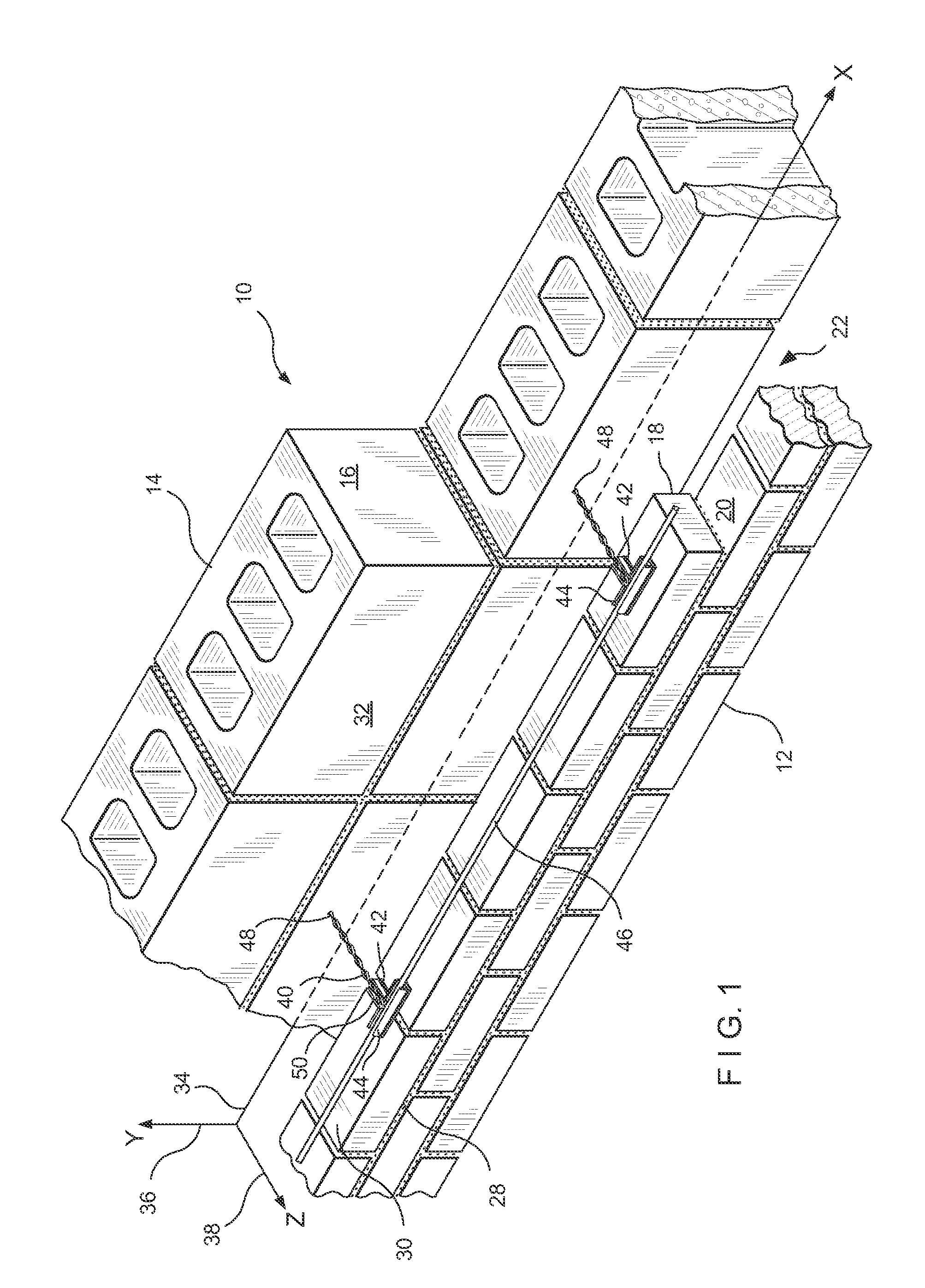Restoration Anchoring System
a technology of anchoring system and cavity wall, which is applied in the direction of shock absorption, covering/lining, building repairs, etc., can solve the problems of masonry veneer cracking and spalling, affecting the economics of manufacture, and requiring remediation of the instability of the cavity wall, etc., and achieves the effect of low unit cost and economics of manufactur
- Summary
- Abstract
- Description
- Claims
- Application Information
AI Technical Summary
Benefits of technology
Problems solved by technology
Method used
Image
Examples
first embodiment
[0049]Referring now to FIGS. 1 through 8, a restoration seismic anchoring system of this invention is shown as applied to an existing cavity wall. The construct is referred to generally by the numeral 10. In this embodiment, a wall structure 12 is shown having an interior wythe 14 of masonry blocks 16 and an exterior wythe 18 of facing brick 20. Between the interior wythe 14 and the exterior wythe 18, a cavity 22 is formed.
[0050]In the first embodiment, successive bed joints 28 and 30 are formed between courses of bricks 20 and the joints are substantially planar and horizontally disposed. For purposes of discussion, the exterior surface 32 of the interior wythe 14 contains a horizontal line or x-axis 34 and an intersecting vertical line or y-axis 36. A horizontal line or z-axis 38 also passes through the coordinate origin formed by the intersecting x- and y-axes.
[0051]The present invention contains three components, namely, the helical dowel 40, the seismic T-clip 44 and the reinfo...
second embodiment
[0057]In the second embodiment, successive bed joints 128 and 130 are formed between courses of bricks 120 and the joints are substantially planar and horizontally disposed. For purposes of discussion, the exterior surface 132 of the interior wythe 114 contains a horizontal line or x-axis 134 and an intersecting vertical line or y-axis 136. A horizontal line or z-axis 138 also passes through the coordinate origin formed by the intersecting x- and y-axes. The exterior surface of the inner wythe 114 is optionally covered in a sheathing or insulative layer 133.
[0058]The present invention contains three components, namely, the helical dowel 180, the seismic T-clip 44 and the reinforcement member 146. The reinforcement member takes the form of another helical dowel or a wire formative, however, it is anticipated that any similar reinforcement member is within the contemplation of this invention. These restoration anchoring components, when installed within the cavity wall structure, seve...
third embodiment
[0065]In the third embodiment, successive bed joints 228 and 230 are formed between courses of bricks 220 and the joints are substantially planar and horizontally disposed. For purposes of discussion, the exterior surface 232 of the interior wythe 214 contains a horizontal line or x-axis 234 and an intersecting vertical line or y-axis 236. A horizontal line or z-axis 238 also passes through the coordinate origin formed by the intersecting x- and y-axes. The exterior surface of the inner wythe 214 is optionally covered in a sheathing or insulative layer (not shown).
[0066]The present invention contains three components, namely, the helical dowel 292 the seismic T-clip 44 and the reinforcement member 246. The reinforcement member takes the form of another helical dowel or a wire formative, however, it is anticipated that any similar reinforcement member is within the contemplation of this invention. These restoration anchoring components, when installed within the cavity wall structure...
PUM
| Property | Measurement | Unit |
|---|---|---|
| height | aaaaa | aaaaa |
| helix angle | aaaaa | aaaaa |
| thermoplastic | aaaaa | aaaaa |
Abstract
Description
Claims
Application Information
 Login to View More
Login to View More - R&D
- Intellectual Property
- Life Sciences
- Materials
- Tech Scout
- Unparalleled Data Quality
- Higher Quality Content
- 60% Fewer Hallucinations
Browse by: Latest US Patents, China's latest patents, Technical Efficacy Thesaurus, Application Domain, Technology Topic, Popular Technical Reports.
© 2025 PatSnap. All rights reserved.Legal|Privacy policy|Modern Slavery Act Transparency Statement|Sitemap|About US| Contact US: help@patsnap.com



